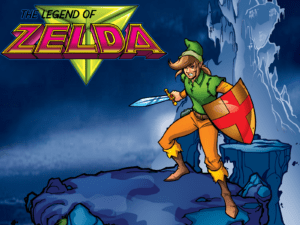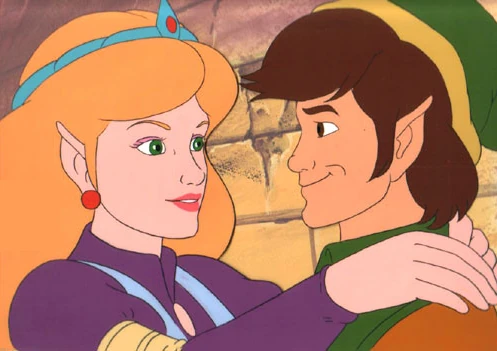Table of Contents
Watch The Legend of Zelda Animated Series
To view all episodes of the Zelda animated series, click the Playlist icon located at the top right of the video.
Series Overview & Premise

Step back into the era of early Nintendo adaptations with The Legend of Zelda, the 1989 American animated series, often fondly remembered as the Zelda cartoon. Produced by DIC Entertainment (known for many 80s cartoons like Inspector Gadget and The Super Mario Bros. Super Show!) and distributed by Viacom Enterprises, this short-lived series offered fans a unique, and often debated, look at the world of Hyrule. Airing for just 13 episodes from September 8 to December 1, 1989, it remains a fascinating piece of Zelda history and a distinct entry among Zelda cartoons.
Drawing inspiration primarily from the first two NES games (The Legend of Zelda and Zelda II: The Adventure of Link), the Zelda animated series chronicles the ongoing struggle between the valiant Link and Princess Zelda and the evil wizard Ganon. Ganon, already possessing the Triforce of Power, relentlessly schemes from his Underworld lair to steal the Triforce of Wisdom, kept safe within Hyrule Castle. Each episode of this Zelda cartoon typically features Ganon launching a new plot, often involving monsters and magic, which Link and Zelda must thwart together to protect the Triforce and the kingdom.

Perhaps the most notable aspect of this adaptation is its portrayal of the main characters:
- Link: Unlike his stoic, silent counterpart in the games, this Link is a vocal, often overconfident teenager. He’s undeniably courageous but also prone to complaining and boasting, constantly seeking a kiss from Zelda. His catchphrase, “Well, excuse me, Princess!”, delivered with exasperation, became the show’s most infamous and enduring line, cementing this Zelda cartoon in meme history.
- Princess Zelda: Far from a damsel in distress, this Zelda is intelligent, resourceful, and actively participates in defending Hyrule. She wields a bow, engages in combat, and often matches Link’s banter, frequently rebuffing his advances while clearly valuing his partnership in the Zelda animated series.
Key Differences from the Games
This Zelda animated series took significant liberties compared to its source material:
- Link Speaks: The most obvious difference is Link having dialogue and a distinct, somewhat brash personality specific to this Zelda cartoon.
- Link & Zelda’s Dynamic: The established, flirtatious yet bickering relationship is unique to the cartoon.
- Episodic Format: Follows a “monster-of-the-week” structure rather than an overarching journey.
- Triforce Status: Ganon already holds the Triforce of Power; the conflict centers on him trying to steal the Triforce of Wisdom.
- Original Characters: Includes characters not found in the early games, like Spryte, created for the animated series.
Main Characters

Link
The hero of Hyrule in this Zelda cartoon, tasked with protecting Zelda and the Triforce of Wisdom, often seeking Zelda’s affection.

Princess Zelda
The capable and intelligent ruler-in-training of Hyrule, fighting alongside Link in the Zelda animated series.

Ganon
The primary antagonist of the Zelda cartoon, a powerful pig-like sorcerer obsessed with obtaining the Triforce of Wisdom to conquer Hyrule.

Spryte
A small, winged fairy companion to Link and Zelda, offering assistance (and harboring a crush on Link) in the animated series.

King Harkinian
Zelda’s father, the benevolent but somewhat naive King of Hyrule featured in the Zelda cartoon.
Narrative Cast

Jonathan Potts (Link)
Canadian actor and voice artist, best remembered as the original speaking voice of Link in The Legend of Zelda animated series and Captain N: The Game Master. Known for Link’s mischievous catchphrase “Well excuse me, Princess!” and a teenage characterization full of impulsive humor. His live‑action credits include Jason X, Cruel Intentions 2, and guest roles on Road to Avonlea, Earth: Final Conflict, Due South, Queer as Folk, and more.

Cynthia (“Cyndy”) Preston (Princess Zelda)
Canadian actress and voice performer of Zelda’s firm, intelligent and self‑reliant personality. Early credits include Super Mario Bros. Super Show! and Captain N, with later guest roles in The X‑Files, CSI, Two and a Half Men, Numb3rs, Bones, Jack Ryan, and Hannibal.

Len Carlson (Ganon & Moblins)
Veteran Canadian voice actor whose interpretation of Ganon balanced comedic villainy with dark ambition. Long career provided voices for shows like Beetlejuice, Donkey Kong Country, X‑Men, Cyberchase, and many more—remaining active until his death in 2006.

Paulina Gillis (Spryte)
Voice of Spryte, the fairy whose rivalry with Zelda and fascination with Link brought playful energy to the series. Gillis also voiced characters in Super Mario Bros. 3, Dragon Ball Z, and appeared on Due South and Stargate SG‑1.

Colin Fox (King Harkinian)
Played King Harkinian with regal presence and understated charm. A long‑time character actor on Canadian television and voice roles in animation like Henry’s World and My Pet Monster.
Broadcast History & The Super Mario Bros. Super Show!
The Legend of Zelda animated series didn’t air as a standalone show initially. Instead, each 15-minute episode was broadcast on Fridays as part of the hour-long syndicated block, The Super Mario Bros. Super Show!. On “Zelda Fridays,” the usual Mario-themed cartoon segment was replaced by Link and Zelda’s adventures in this specific Zelda cartoon, sandwiched between the show’s live-action comedic segments starring Captain Lou Albano as Mario and Danny Wells as Luigi.
Episode Guide for the Zelda Cartoon
- The Ringer: Ganon infiltrates a Hyrule Castle magic contest in disguise to snatch the Triforce of Wisdom.
- Cold Spells: Spryte misuses the Triforce’s magic, accidentally letting Ganon get his hands on it temporarily.
- The White Knight: A boastful visiting prince, Facade, tries to woo Zelda but proves useless against a real threat from Ganon.
- Kiss ‘N Tell: A Gibdo disguised as a maiden tricks Link into a kiss, transforming him into a humanoid frog.
- Sing for the Unicorn: Ganon captures King Harkinian using a kidnapped unicorn; Link and Zelda must team up with the unicorn’s rightful owner to rescue them both.
- That Sinking Feeling: Ganon attempts to literally sink Hyrule Castle by having his minions tunnel beneath it.
- Doppelganger: A magical mirror creates an evil duplicate of Zelda, sowing chaos until the heroes can shatter the illusion.
- Underworld Connections: Link and Zelda must brave Ganon’s domain, the Underworld, to recover stolen Triforce pieces.
- Stinging a Stinger: Ganon tricks Link into trading his magic sword for a worthless fake right before an attack.
- A Hitch in the Works: Sabotage at Hyrule’s new water park leads to mechanical chaos only Link and Zelda can fix.
- Fairies in the Spring: Trouble with Hyrule’s water source leads the duo to discover and help a hidden community of fairies.
- The Missing Link: Ganon finally captures Link, forcing Zelda to take the lead and mount a daring rescue mission into the Underworld.
- The Moblins Are Revolting: With Ganon temporarily indisposed, his Moblin minions attempt to take over his lair, forcing Link and Zelda to intervene.
Cultural Impact and Reception of the Zelda Animated Series
Decades later, the Zelda animated series holds a peculiar place in fan memory. Upon release and through the years, this Zelda cartoon has garnered mixed reactions. Critics often point to the sometimes-limited animation (typical of DIC cartoons of the time), the campy humor, and particularly the portrayal of Link, which contrasts sharply with the silent protagonist of the games.
However, the animated series also enjoys a cult following. For many, this specific Zelda cartoon is a source of nostalgia, representing their first exposure to Zelda outside the games. Its unique take on the characters, especially Link’s infamous catchphrase, has achieved meme status online. While drastically different in tone from modern Zelda titles, the Zelda animated series remains a memorable, if quirky, product of its time.
Physical Media Availability

- Physical Media: The complete Zelda animated series has been released on DVD and may be available from retailers or secondhand markets. Look for “The Legend of Zelda: The Complete Animated Series” DVD.
- Streaming (As of April 2025): Availability on subscription services changes frequently. While previously on platforms like Amazon Prime Video, the Zelda cartoon might currently be found on free, ad-supported services like Tubi or Pluto TV in some regions. It may also be available for digital purchase on platforms like Vudu or Apple TV. (Always check current platform libraries, as availability can vary by region and time).
Additional Series Character Appearances

Further cementing their place in 80s Nintendo animation, versions of this Link and Zelda also appeared as recurring characters in Captain N: The Game Master, another DIC cartoon featuring heroes pulled from various Nintendo games, sharing screen time with characters like Mega Man and Kid Icarus. This further exposed the interpretations from the Zelda animated series to a wider audience.




















